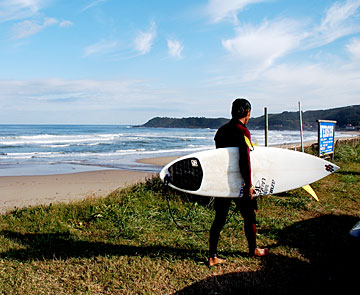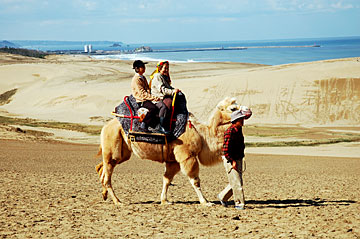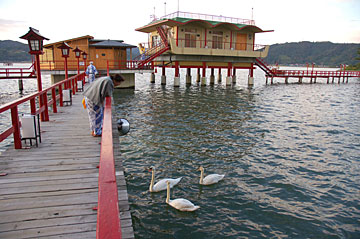
GREGG K. KAKESAKO / GKAKESAKO@STARBULLETIN.COM
It isn't Diamond Head, but a Japanese surfer returns to the beach at Ishiwaki near Hawai-cho after a morning of riding the "beach breaks." Surfing is one of the favorite sports, especially during the summer, at this western Japanese coastal town off the Sea of Japan.
|
|
Aloha from Hawai...Japan
A sister-city relationship with Hawaii County has expanded cultural ties
HAWAI, Japan » With many sandy beaches, this community of nearly 8,000 tries to be a "Japanese Hawaii."
The summertime playground where Japanese can do everything they could do in Hawaii -- bask on beaches, swim, surf, Jet-ski and fish -- without a passport.
For nearly a decade, Hawai, Japan, has fostered close ties with the Aloha State.
On the west side of Japan's main island of Honshu on the Sea of Japan, Hawai-cho was incorporated with two other towns -- Togo and Tomari -- last year and collectively the three municipalities are known as Yurihama-cho, representing the major attractions of the three towns. "Yu" is for the host mineral springs, "ri" for the nashi or pears, and "hama" for beach.
Tamotsu Fukuyama, director of Yurihama-cho's planning and information division, explained that in formal written Japanese, the name of his city for centuries was "Haai."
"When people say it," Fukuyama said, "it sounds like Hawaii."
The name Hawai was officially adopted in 1953 when four villages -- Asozu, Hashizu, Nagase and Uno -- were brought together.
TO THE NORTH there are two sandy Sea of Japan beaches, Hawai and Hashizu, which has decent "beach breaks," according to local surfers. However, much of the surfing seems to depend on storm surges and is quite unpredictable.
Moving south is the popular Hawai Onsen (spa) area, where, local legends say, hot water from Lake Togo was used for baths on the boats. Numerous onsens (mineral hot-spring spas) and ryokans, or Japanese inns, dot the shores of the picturesque setting surrounding the two-mile Lake Togo where visitors can bathe in the hot springs in natural settings and, in some places, in the open air.
Throughout the prefecture, or state, of Tottori -- where Yurihama is located -- are beaches and scenic vistas. There is even a local surf shop called "Versus" that sells Hawaii items near Ishiwaki Beach.
In 1996, Michele Otake, a student from Hawaii who taught English for three years in Tottori Prefecture, was so enthusiastic over her teaching experience that she sought to build a connection with the islands after she left.
The sister-city relation with Hawaii County was established while Stephen Yamashiro served as Big Island mayor from 1992 to 2000. That tie has resulted in annual visits by political, business, and community leaders and students from both sides.
There is a restaurant adjacent to the city's eight-year-old 494-seat concert hall on Highway 320 whose specialty, besides sashimi and hamburger steak, includes a Japanese version of loco-moco. With Hawaiian music blaring out of the jukebox, Hawaii Kitchen Cafe Luau's owner Mikio "Kimo" Iwamoto also displays letters of appreciation from former Gov. John Waihee and Yamashiro on his walls along with other Hawaiian paraphernalia.

GREGG K. KAKESAKO / GKAKESAKO@STARBULLETIN.COM
Japan's "Sahara" might only stretch a little more than 33 feet along the western coast fronting the Sea of Japan, but the dunes of Tottori-sakyu are well known.
|
|

GREGG K. KAKESAKO / GKAKESAKO@STARBULLETIN.COMBathers admire the scenery before a visit to an outdoor onsen (hot water mineral spa).
|
|
ART TANIGUICHI, Bank of Hawaii vice president and past president of the Big Island's Japanese Chamber of Commerce and Industry, notes that there is even an aloha shirt that Reyn's made for his bank in 1977 which he gave to Iwamoto during a goodwill visit.
Yamashiro, who visited Hawai-cho several times during his tenure, said the tiny Japanese community is one of three towns with which the Big Island county has developed a sister-city relationship. "Hawai-cho, now called Yurihama, is trying to re-focus its economy into tourism and take advantage of their name."
Andrew Levin, who has coordinated the Big Island's sister-city programs for the past five years as the mayor's executive assistant, said the county requires that each city in Japan have a sponsor. In the case of Hawai-cho, now Yurihama-cho, it has been the Japanese Chamber of Commerce and Industry, headed this year by stock broker Dwayne Mukai.
Mukai said a delegation from Yurihama-cho visits the Big Island each year and in July during its Hawai matsuri, or festival, a halau from Hilo travels to the Japanese city to help with its hula festival. This summer it was the dancers from Emery Acret's Halau Na Pua O Uluhaimalama which held hula, lei making and ukulele classes.
"They have so much aloha for us that it is frightening at times," added Mukai, who visited the city this summer. "They have a Hawaiian flag flying at our hotel when we arrived. They really pride themselves in the relationship. In fact in July all government employees wear aloha shirts to work."
Fukuyama, who has watched the relationship develop over the past decade, worries that after the merger of Hawai-cho with the neighboring towns of Tomari (population 4,000) and Togo (population 6,000) to create Yurihama, the ties to the Aloha State may diminish.
He said he is concerned that the friendly rural lifestyle that was the charm of Hawai-cho will be lost.
HAWAI-CHO: HAWAII'S SISTER
Population: 7,751
Percentage of people older than 65: 22.3 percent
Total acreage: 3,018 acres
Farm land: 1,482 acres (41 percent)
Residential land: 347 acres (11.5 percent)
Forest area: 343 acres (11.4 percent)
Waterways: 191 acres (6.3 percent)
Roads: 241 acres (8 percent)
Nearby attractions:
» Tottori-sakyu (The Dunes): Sixteen miles from Tottori City, the sand dunes stretch 33 feet along the coast. It was the location for the 1964 Japanese film "Woman in the Dunes."
» Mount Daisen: At more than 5,700 feet the popular extinct volcano is one of western Japan's top ski areas.
Source: Division of Planning and Tourism, Hawai-cho
HOW TO GET THERE
From Tokyo: It's a one hour and 10 minute flight between Tokyo and the Tottori City Airport west of the town. From Tottori City, take the train to Kurayoshi-cho, a one-hour ride, and a 15-minute bus ride to Yurihama. Or take the JR train to Kyoto, transferring to another train to Kurayoshi.
From Osaka: You have a choice of bus or train to Kurayoshi. It takes about three hours and 30 minutes by the Chizu express train. The bus ride from Osaka to Kurayoshi is about four hours.
By car from Fukuoka: Take the Chugoku Expressway to the Innosho Interchange and then take Route 179 north.
|
Fukuyama points to his frequent visits to the Big Island and its tradition of potluck dinners where the Japanese delegation and students are feted.
"In Japan, traditions like that are dying," Fukuyama added.
HILO HIGH SCHOOL junior Cami Nagata spent 3 1/2 weeks in Hawai-cho in 2001 as a guest of three families as part of a student exchange program. A year later her Big Island family hosted Yurika Kitada, whom she met while attending Hokumei Middle School.
The educational and cultural experience, which included classes in tea ceremony and calligraphy, piqued her interest in Japan. She hopes to return to Hawai-cho next spring either with her Hilo High Japanese class or as a member of the school's Key Club.
In August about a dozen students from Hokumei and Togo middle schools spent a week on the Big Island as part of the same student exchange program hosted by the Japanese Chamber of Commerce and Industry.
"I really learned a lot," Nagata said. "It increased my interest in Japan and the Japanese culture."
There has been a decline in the interest in the student-exchange program between Hilo and Hawai-cho junior high schools but Fukuyama hopes to revive it.
"All Japanese students have studied English from middle to high school," Fukuyama said. "Their reading and writing skills are good, but their speaking is very poor. Programs like this will help to motivate them, making them better students and people."
Fukuyama said he also likes the philosophy of Big Island Mayor Harry Kim and his desire for a more peaceful world community.
"These student-exchange programs also helps to promote world peace," Fukuyama added. "The more exposure these students have to other people, the more likely they will be open to other cultures in the end."

